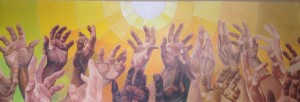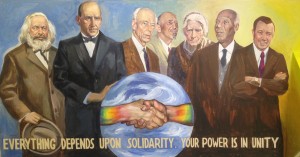Herman Hulman Auditorium

Basically unused when Debs lived here, it was used as a sleeping room by the fraternity men. It was refinished by the Foundation with financing from Anton Hulman, Jr. as a memorial to his grandfather’s friendship with Debs. The murals were painted by John Laska, former Professor of Art at Indiana State University and active Foundation member. Completed in 1979 after three years of hard work, the murals depict Debs’ life and time in chronological order, with the early years and family appearing above the stairwell. Here also are pictures of Victor Hugo, Jean Sey, and Voltaire, three French Enlightenment writers who were much read in the Debs home. Then come scenes from Debs’ years on the railroad- -paintshop, then fireman- -and then Debs as clerk in the Hulman wholesale grocery firm. Note the scenes of accidents and death, which were all too frequent occurrences on the railroads in those days. It was because of the dangers of railroad work that Debs’ mother persuaded him to give up work as a locomotive fireman.

Facing back down the room from the top of the T, you see murals depicting the range of Debs’ involvements: union organizing on the right side and then scenes depicting such causes as the rights of women and children. Susan B. Anthony is pictured here, as is Dorothy Day. In his ealry days, Debs sponsored Susan B. Anthony for a speaking engagement in Terre Haute- -an early sign of his “radicalism!” Turning to the west wall murals, on the left you see scenes from the Pullman episode: attempts at negotiations, demonstrations, federal troops, head-bashing by Pinkerton guards, and the trial of Debs. Although represented in court by the famous Clarence Darrow, Debs and the other union leaders were convicted, and Debs had to spend six months in Woodstock Jail in 1895. While in Woodstock, Debs had ample time to reflect on the need for political change if unions were to be successful. He was visited frequently by such Socialists as Victor Berger from Milwaukee, and he eventually joined in forming the American Socialist Party. As mentioned earlier, Debs ran five times as the party’s candidate for president. On the right of this wall is Debs’ famous statement, “While there is…,” which was uttered during his sentencing hearing in 1919, when as a man of age 64 he was about to be sent to prison for having spoken out against U.S. involvement in World War I. The last murals, across from the stairs, show later prominent union leaders such as A. Philip Randolph, Walter Reuther, and Cesar Chavez.
